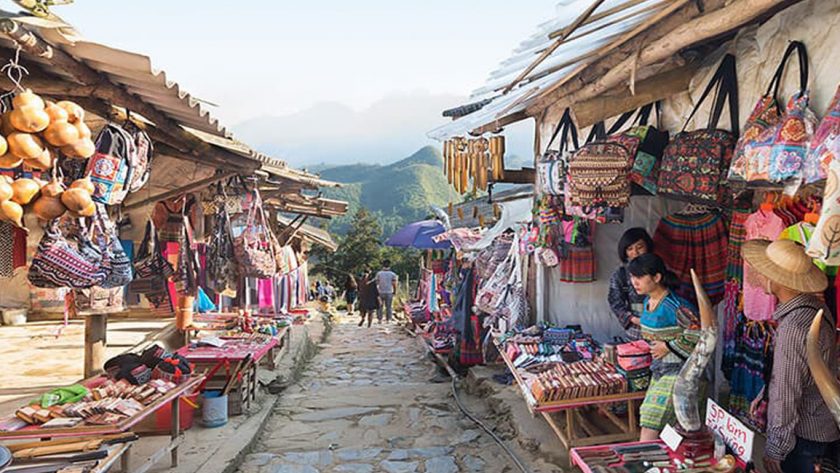I am a woman who loves to shop. I love shopping. I can shop for anything but I especially like buying clothes, music, books and silk lanterns, as I’ve recently discovered. This odd revelation came upon me while I was traveling through Hoi An, a small town tucked halfway up the S-shaped curve of Vietnam. I first learned about Hoi An during a trip to Fiji, from a girl whose face lit up as she described to me the wondrous shopping mecca of the ancient village. She said I could get all sorts of dresses, shirts and pants tailored to my specifications and, more importantly, they were unbelievably cheap. After months of anticipation, I was certainly not disappointed when I finally arrived and have only just escaped, reeling from days of intense shopping.
Hoi An also is renowned for its excellent seafood restaurants. Each day you can see young men hauling in their catch with long orange nets. They balance precariously on the edges of flat long-tail boats, punted by old women in conical hats. The town is pleasant and charming. No bars blare out tacky Western music and the few karaoke joints, so beloved by the Vietnamese, are on the outskirts. The town center is small and mostly quiet, except very early in the morning and at about five in the evening, when the swarm of bicycles and motos crowd the streets.
Hoi An used to be an important international port, until the Thu Bon river silted up in the late 19th century and cut it off from the sea. Before that happened, an exotic mix of Chinese, Japanese, French, Dutch and Portuguese merchants gathered there and traded fine silks, paper and porcelain, as well as foodstuffs and Oriental medicines. I was there not to trade but to participate in frenzied consumerism, like most tourists to Hoi An today. People now come to buy artwork, faux antiques, lamps and bags. But mostly, they come to buy clothes. There are hundreds of tailor shops, all displaying fabric from floor to ceiling, littered with well-fingered copies of Vogue and Elle.
There is fierce competition between the shops. on the morning of my arrival in Hoi An, I encountered a young girl on the bridge that leads into the city and spans the Thu Bon River. She mentioned that she had a dress shop in the market. Would I like to come and have a look? Since I had come to shop and shop some more, I agreed, though I warned her that I would just be browsing. I quickly realized that there is no such thing as just browsing in Hoi An. Before I could pause to collect my thoughts, I was standing with arms stretched wide, being outfitted for a blouse and a top.
After my afternoon of reconnaissance, I went to bed early to prepare myself for my big day of shopping. My mind filled with images of various fabrics and fashions and cuts. How much to get made, where to get it made, what to get for my friends, could they send me their measurements in time? Eventually sleep came on.
Making my way into town the next day, I lumbered down to the muddy silt on the river’s edge where an old Vietnamese woman sat on a flat wooden boat and madly gesticulated at me. The early morning sun played brightly on the water as we bargained awkwardly, holding out notes and pointing to numbers. We agreed on a price and she grinned, exposing teeth stained black from years of chewing betel nut. I clambered in and she punted the boat across the brown waters to the market. The traditional coned hat is still worn all over Vietnam, and I climbed out of the boat into a bobbing sea of conical hats bustling through the pungent fish market.
I hurried through to the Old Quarter, where the streets were quiet and still. For an hour I walk around, trying to clear my head of my fevered dreams. I strolled past countless art galleries. Every corner seemed to reveal a treasure. The international tradesmen from hundreds of years ago have left vestiges of their presence, which remain visible to this day. I stumbled across numerous Chinese Assembly Halls and a bridge built by the Japanese in 1592, which still arches prettily over a ribbon of water. The most obvious influence is that of the colonial French, who rebuilt swaths of the city after its virtual destruction during the Tay Son rebellion of the 1870s. Wandering through the quiet streets I was charmed by Hoi An’s narrow buildings, which seemed to have been frozen in time. Muted yellows, blues and reds, washed onto the rough plaster walls, contrast with the dark wooden shop fronts and captured the sun’s hot rays. Many buildings had balconies of wood or finely wrought iron, some draped in greenery. I joined the locals along the pavement and drank freshly percolated coffee served with condensed milk, crouching on a minute plastic chair.
Feeling revived, I ventured forth to one of the larger shops I had seen the previous day. It had been recommended in guidebooks and besides, I had seen gorgeous winter coats in its front display. I wandered in and was greeted warmly; I was their first customer of the day. Despite the sticky heat, I was soon wrapped up in a long coat, issuing details on how I wanted my own made. Never let practicalities hinder the beauty of a shopping experience. A few hours later, I had my coat as well as a suit and some blouses ordered and my first fitting appointment scheduled for later that afternoon. I decided to move on. A waiter at our hotel, in defiance of the boss and his tailor shop, had covertly recommended my next destination. Here I ordered a skirt and matching top in one of the myriad Chinese silks, making my choices cautiously.
That is pretty much how I spent all my time in Hoi An, intensive days of appointments and fittings from early morning until sometimes 10 in the evening, interspersed only with quick coffees and drop-offs at the hotel. I am truly in awe of my own shopping capabilities. The result was a beautiful new wardrobe of tailored, one-of-a-kind clothes: suits, dresses, coats, trousers and shoes. Such treasures made the prospect of returning to an English winter seem almost appealing. Those five days were fantastic fun, a backpacker’s budget version of the life of the rich and famous.
Hoi An had more to offer than just shopping, however. one night, as I walked through the old quarter of the city to meet my friends at a cafe, I stumbled onto a magical sight. It was the Festival of the Moon, an ancient tradition in Vietnam. Hundreds of silk lanterns, in all the colors of the rainbow, were strung overhead. Through the hordes I caught sight of two small Chinese dragons, glowing red and yellow in the darkly lit street. They stomped and shook their heads to the beat of a tall drum. In syncopation, they moved together and then in opposition, each skillfully controlled by two boys, one working the head and the other the haunches. Awkwardly positioned in a jostling crowd, I watched in awe.
They were practicing at the back of a long line of floats and costumes, a waiting procession that wound up the street as far as I could see. Hurriedly, I cut through some streets and walked past connecting alleys in a dream, catching glimpses of bright color and snatches of music. Emerging at last, I saw my friends transfixed by the spectacle before them. The parade had begun and we followed it down to the riverside. Floating behind us coronets of colored paper containing tiny dancing flames rested on the waters; in the darkness they could have been drifting through the air. Floats depicting scenes from Hoi An’s past went by, manned by beautifully dressed children, smiling and waving like gracious royalty. A bevy of pony-tailed princesses, fierce warriors armed with curved cardboard swords and a square-sailed cutter with a crew in striped T-shirts all passed. Next came a menagerie of paper mache animals: fire breathing dragons, horses and my favorite, a miniature elephant carrying a tiny emperor.
I looked around at my friends and we all smiled wordlessly, immersed in the magical night. It was a spectacular sight that I will treasure long after my new clothes have lost their appeal.



